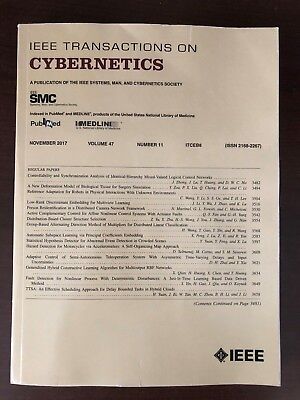具有竞争相互作用的时空社区网络的固定时间无领导集群同步。
IF 10.5
1区 计算机科学
Q1 AUTOMATION & CONTROL SYSTEMS
引用次数: 0
摘要
本文研究了具有非同构节点动态和反应扩散特征的时空社区网络的固定时间无领导集群同步问题。首先,建立了一个具有反应扩散效应的签名SCN,其中引入了基于符号的耦合来捕捉不同群落之间合作互动的动态。其次,为了保证同步流形的不变性,提出了一种改进的度间平衡条件,作为实现社区网络集群同步的前提条件。第三,基于社区内相邻节点的本地状态信息,设计了限时控制器,增强了社区内的协调能力,同时避免了社区间竞争对同步的不利影响。随后,利用矩阵分解技术和类李雅普诺夫方法,通过建立一个非平凡积分不等式和群体内拉普拉斯矩阵的关键性质,推导出若干灵活的无领导集群同步准则。最后,通过数值算例对理论结果进行了验证。本文章由计算机程序翻译,如有差异,请以英文原文为准。
Fixed-Time Leaderless Cluster Synchronization of Spatiotemporal Community Networks With Coopetition Interactions.
This article addresses the fixed-time leaderless cluster synchronization of spatiotemporal community networks (SCNs) characterized by nonidentical node dynamics and reaction-diffusion feature. First, a signed SCN with reaction-diffusion effect is formulated, where the sign-based coupling is introduced to capture the dynamics of coopetition interactions among different communities. Second, to ensure the invariance of the synchronous manifold, an improved interdegree balance condition is proposed as a prerequisite for achieving cluster synchronization of the community network. Third, based on the local state information from adjacent nodes within each community, a time-limited controller is designed to enhance intracommunity coordination while avoiding the adverse effects of intercommunity competition on synchronization. Subsequently, with the help of the matrix decomposition technique and a Lyapunov-like method, several flexible leaderless cluster synchronization criteria are derived by establishing a nontrivial integral inequality and key properties of the intracommunity Laplacian matrix. Finally, the theoretical results are substantiated through a numerical example.
求助全文
通过发布文献求助,成功后即可免费获取论文全文。
去求助
来源期刊

IEEE Transactions on Cybernetics
COMPUTER SCIENCE, ARTIFICIAL INTELLIGENCE-COMPUTER SCIENCE, CYBERNETICS
CiteScore
25.40
自引率
11.00%
发文量
1869
期刊介绍:
The scope of the IEEE Transactions on Cybernetics includes computational approaches to the field of cybernetics. Specifically, the transactions welcomes papers on communication and control across machines or machine, human, and organizations. The scope includes such areas as computational intelligence, computer vision, neural networks, genetic algorithms, machine learning, fuzzy systems, cognitive systems, decision making, and robotics, to the extent that they contribute to the theme of cybernetics or demonstrate an application of cybernetics principles.
 求助内容:
求助内容: 应助结果提醒方式:
应助结果提醒方式:


